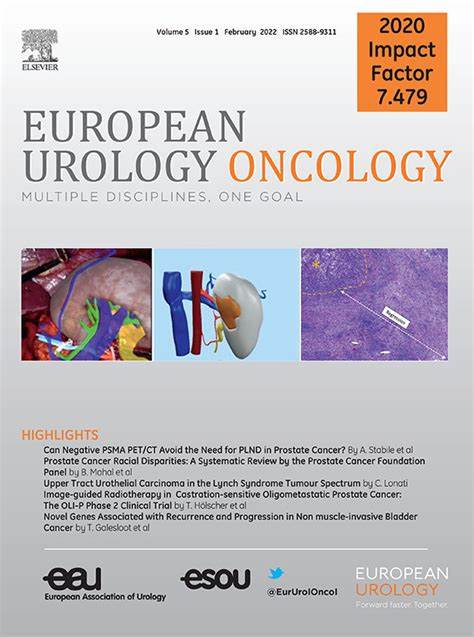Assessing the Clinical Utility of Published Prostate Cancer Polygenic Risk Scores in a Large Biobank Data Set
IF 8.3
1区 医学
Q1 ONCOLOGY
引用次数: 0
Abstract
Background and objective
Polygenic risk scores (PRSs) have been developed to identify men with the highest risk of prostate cancer. Our aim was to compare the performance of 16 PRSs in identifying men at risk of developing prostate cancer and then to evaluate the performance of the top-performing PRSs in differentiating individuals at risk of aggressive prostate cancer.
Methods
For this case-control study we downloaded 16 published PRSs from the Polygenic Score Catalog on May 28, 2021 and applied them to Michigan Genomics Initiative (MGI) patients. Cases were matched to the Michigan Urological Surgery Improvement Collaborative (MUSIC) registry to obtain granular clinical and pathological data. MGI prospectively enrolls patients undergoing surgery at the University of Michigan, and MUSIC is a multi-institutional registry that prospectively tracks demographic, treatment, and clinical variables. The predictive performance of each PRS was evaluated using the area under the covariate-adjusted receiver operating characteristic curve (aAUC), and the association between PRS and disease aggressiveness according to prostate biopsy data was measured using logistic regression.
Key findings and limitations
We included 18 050 patients in the analysis, of whom 15 310 were control subjects and 2740 were prostate cancer cases. The median age was 66.1 yr (interquartile range 59.9–71.6) for cases and 56.6 yr (interquartile range 42.6–66.7) for control subjects. The PRS performance in predicting the risk of developing prostate cancer according to aAUC ranged from 0.51 (95% confidence interval 0.51–0.53) to 0.67 (95% confidence interval 0.66–0.68). By contrast, there was no association between PRS and disease aggressiveness.
Conclusions and clinical implications
Prostate cancer PRSs have modest real-world performance in identifying patients at higher risk of developing prostate cancer; however, they are limited in distinguishing patients with indolent versus aggressive disease.
Patient summary
Risk scores using data for multiple genes (called polygenic risk scores) can identify men at higher risk of developing prostate cancer. However, these scores need to be refined to be able to identify men with the highest risk for clinically significant prostate cancer.
在大型生物库数据集中评估已发布的前列腺癌多基因风险评分的临床实用性。
背景和目的:多基因风险评分(PRSs)被用来识别罹患前列腺癌风险最高的男性。我们的目的是比较 16 个多基因风险评分在识别前列腺癌高危男性方面的表现,然后评估表现最好的多基因风险评分在区分侵袭性前列腺癌高危个体方面的表现:在这项病例对照研究中,我们于 2021 年 5 月 28 日从多基因评分目录(Polygenic Score Catalog)中下载了 16 个已发布的 PRS,并将它们应用于密歇根基因组学倡议(Michigan Genomics Initiative,MGI)患者。病例与密歇根州泌尿外科手术改进协作组(MUSIC)登记处进行匹配,以获得详细的临床和病理数据。MGI 对在密歇根大学接受手术的患者进行前瞻性登记,而 MUSIC 是一个多机构登记系统,对人口统计学、治疗和临床变量进行前瞻性跟踪。我们使用协变量调整后接收者操作特征曲线下面积(aAUC)评估了每个前列腺特异性指标的预测性能,并根据前列腺活检数据使用逻辑回归测量了前列腺特异性指标与疾病侵袭性之间的关联:我们在分析中纳入了 18 050 名患者,其中 15 310 人为对照组,2740 人为前列腺癌病例。病例的中位年龄为 66.1 岁(四分位数间距为 59.9-71.6),对照组的中位年龄为 56.6 岁(四分位数间距为 42.6-66.7)。根据aAUC,PRS在预测前列腺癌发病风险方面的表现介于0.51(95%置信区间0.51-0.53)和0.67(95%置信区间0.66-0.68)之间。相比之下,PRS与疾病侵袭性之间没有关联:前列腺癌PRS在识别前列腺癌高风险患者方面具有适度的现实表现;但是,它们在区分疾病的隐匿性和侵袭性方面存在局限性:使用多基因数据的风险评分(称为多基因风险评分)可以识别罹患前列腺癌风险较高的男性。然而,这些评分还需要进一步完善,以便能够识别出临床上罹患前列腺癌风险最高的男性。
本文章由计算机程序翻译,如有差异,请以英文原文为准。
求助全文
约1分钟内获得全文
求助全文
来源期刊

European urology oncology
Multiple-
CiteScore
15.50
自引率
2.40%
发文量
128
审稿时长
20 days
期刊介绍:
Journal Name: European Urology Oncology
Affiliation: Official Journal of the European Association of Urology
Focus:
First official publication of the EAU fully devoted to the study of genitourinary malignancies
Aims to deliver high-quality research
Content:
Includes original articles, opinion piece editorials, and invited reviews
Covers clinical, basic, and translational research
Publication Frequency: Six times a year in electronic format
 求助内容:
求助内容: 应助结果提醒方式:
应助结果提醒方式:


